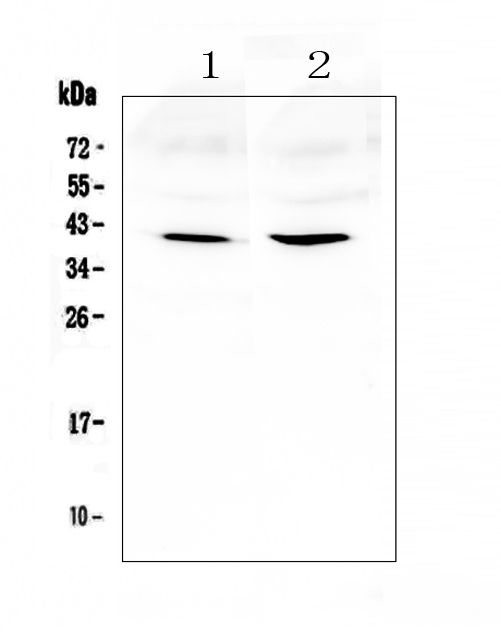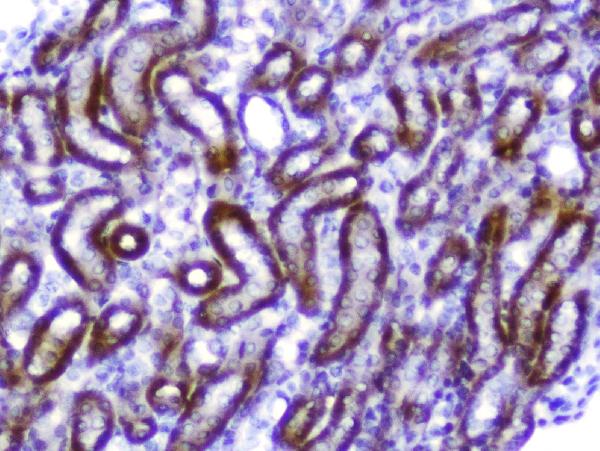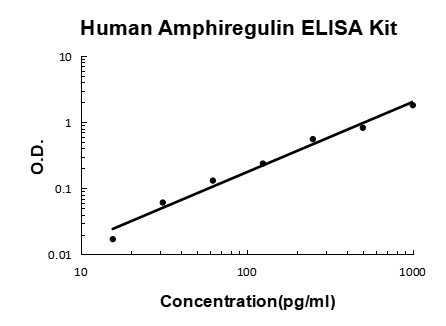Product Info Summary
| SKU: | A01787-1 |
|---|---|
| Size: | 100 μg/vial |
| Reactive Species: | Mouse, Rat |
| Host: | Rabbit |
| Application: | ELISA, IHC, WB |
Customers Who Bought This Also Bought
Product info
Product Name
Anti-Amphiregulin/Areg Antibody Picoband®
View all Amphiregulin Antibodies
SKU/Catalog Number
A01787-1
Size
100 μg/vial
Form
Lyophilized
Description
Boster Bio Anti-Amphiregulin/Areg Antibody Picoband® catalog # A01787-1. Tested in ELISA, IHC, WB applications. This antibody reacts with Mouse, Rat. The brand Picoband indicates this is a premium antibody that guarantees superior quality, high affinity, and strong signals with minimal background in Western blot applications. Only our best-performing antibodies are designated as Picoband, ensuring unmatched performance.
Storage & Handling
Store at -20˚C for one year from date of receipt. After reconstitution, at 4˚C for one month. It can also be aliquotted and stored frozen at -20˚C for six months. Avoid repeated freeze-thaw cycles.
Cite This Product
Anti-Amphiregulin/Areg Antibody Picoband® (Boster Biological Technology, Pleasanton CA, USA, Catalog # A01787-1)
Host
Rabbit
Contents
Each vial contains 4mg Trehalose, 0.9mg NaCl, 0.2mg Na2HPO4, 0.05mg NaN3.
Clonality
Polyclonal
Isotype
Rabbit IgG
Immunogen
E. coli-derived mouse Amphiregulin recombinant protein (Position:V100-K191).
*Blocking peptide can be purchased. Costs vary based on immunogen length. Contact us for pricing.
Cross-reactivity
No cross-reactivity with other proteins.
Reactive Species
A01787-1 is reactive to Areg in Mouse, Rat
Reconstitution
Add 0.2ml of distilled water will yield a concentration of 500ug/ml.
Observed Molecular Weight
41 kDa
Calculated molecular weight
57862 MW
Background of Amphiregulin
Amphiregulin, also known as AREG, is a protein that in humans is encoded by the AREG gene. The protein encoded by this gene is a member of the epidermal growth factor (EGF) family. It is an autocrine growth factor as well as a mitogen for astrocytes, Schwann cells, fibroblasts. It is related to epidermal growth factor (EGF) and transforming growth factor alpha (TGF-alpha). This protein interacts with the Epidermal growth factor receptor (EGFR) to promote the growth of normal epithelial cells. It is mapped to 9q32. It has been shown to play a role in immunity, inflammation, tissue repair, and lung and mammary gland development. Homozygous knockout mice for this gene exhibit impaired immune system regulation in the skin and gene expression changes characteristic of chronic liver damage.
Antibody Validation
Boster validates all antibodies on WB, IHC, ICC, Immunofluorescence, and ELISA with known positive control and negative samples to ensure specificity and high affinity, including thorough antibody incubations.
Application & Images
Applications
A01787-1 is guaranteed for ELISA, IHC, WB Boster Guarantee
Assay Dilutions Recommendation
The recommendations below provide a starting point for assay optimization. The actual working concentration varies and should be decided by the user.
Western blot, 0.1-0.5μg/ml
Immunohistochemistry (Paraffin-embedded Section), 0.5-1μg/ml
ELISA (Cap), 1-5μg/ml
Positive Control
WB: rat brain tissue, mouse brain tissue
IHC: mouse kidney tissue
Validation Images & Assay Conditions

Click image to see more details
Figure 1. Western blot analysis of Amphiregulin using anti-Amphiregulin antibody (A01787-1).
Electrophoresis was performed on a 5-20% SDS-PAGE gel at 70V (Stacking gel) / 90V (Resolving gel) for 2-3 hours. The sample well of each lane was loaded with 50ug of sample under reducing conditions.
Lane 1: rat brain tissue lysates,
Lane 2: mouse brain tissue lysates.
After Electrophoresis, proteins were transferred to a Nitrocellulose membrane at 150mA for 50-90 minutes. Blocked the membrane with 5% Non-fat Milk/ TBS for 1.5 hour at RT. The membrane was incubated with rabbit anti-Amphiregulin antigen affinity purified polyclonal antibody (Catalog # A01787-1) at 0.5 μg/mL overnight at 4°C, then washed with TBS-0.1%Tween 3 times with 5 minutes each and probed with a goat anti-rabbit IgG-HRP secondary antibody at a dilution of 1:10000 for 1.5 hour at RT. The signal is developed using an Enhanced Chemiluminescent detection (ECL) kit (Catalog # EK1002) with Tanon 5200 system. A specific band was detected for Amphiregulin at approximately 41KD. The expected band size for Amphiregulin is at 28KD.

Click image to see more details
Figure 2. IHC analysis of Amphiregulin using anti-Amphiregulin antibody (A01787-1).
Amphiregulin was detected in paraffin-embedded section of mouse kidney tissue. Heat mediated antigen retrieval was performed in EDTA buffer (pH8.0, epitope retrieval solution). The tissue section was blocked with 10% goat serum. The tissue section was then incubated with 1μg/ml rabbit anti-Amphiregulin Antibody (A01787-1) overnight at 4°C. Biotinylated goat anti-rabbit IgG was used as secondary antibody and incubated for 30 minutes at 37°C. The tissue section was developed using Strepavidin-Biotin-Complex (SABC) (Catalog # SA1022) with DAB as the chromogen.
Protein Target Info & Infographic
Gene/Protein Information For Areg (Source: Uniprot.org, NCBI)
Gene Name
Areg
Full Name
Amphiregulin
Weight
57862 MW
Superfamily
amphiregulin family
Alternative Names
Amphiregulin; AR; Schwannoma-derived growth factor; SDGF; Areg; Sdgf AREG ARB, CRDGF, SDGF, AREG amphiregulin amphiregulin|amphiregulin B|colorectum cell-derived growth factor|schwannoma-derived growth factor
*If product is indicated to react with multiple species, protein info is based on the gene entry specified above in "Species".For more info on Areg, check out the Areg Infographic

We have 30,000+ of these available, one for each gene! Check them out.
In this infographic, you will see the following information for Areg: database IDs, superfamily, protein function, synonyms, molecular weight, chromosomal locations, tissues of expression, subcellular locations, post-translational modifications, and related diseases, research areas & pathways. If you want to see more information included, or would like to contribute to it and be acknowledged, please contact [email protected].
Specific Publications For Anti-Amphiregulin/Areg Antibody Picoband® (A01787-1)
Hello CJ!
No publications found for A01787-1
*Do you have publications using this product? Share with us and receive a reward. Ask us for more details.
Recommended Resources
Here are featured tools and databases that you might find useful.
- Boster's Pathways Library
- Protein Databases
- Bioscience Research Protocol Resources
- Data Processing & Analysis Software
- Photo Editing Software
- Scientific Literature Resources
- Research Paper Management Tools
- Molecular Biology Software
- Primer Design Tools
- Bioinformatics Tools
- Phylogenetic Tree Analysis
Customer Reviews
Have you used Anti-Amphiregulin/Areg Antibody Picoband®?
Submit a review and receive an Amazon gift card.
- $30 for a review with an image
0 Reviews For Anti-Amphiregulin/Areg Antibody Picoband®
Customer Q&As
Have a question?
Find answers in Q&As, reviews.
Can't find your answer?
Submit your question
5 Customer Q&As for Anti-Amphiregulin/Areg Antibody Picoband®
Question
We are currently using anti-Amphiregulin/Areg antibody A01787-1 for rat tissue, and we are well pleased with the ELISA results. The species of reactivity given in the datasheet says mouse, rat. Is it likely that the antibody can work on zebrafish tissues as well?
S. Miller
Verified customer
Asked: 2017-11-21
Answer
The anti-Amphiregulin/Areg antibody (A01787-1) has not been tested for cross reactivity specifically with zebrafish tissues, but there is a good chance of cross reactivity. We have an innovator award program that if you test this antibody and show it works in zebrafish you can get your next antibody for free. Please contact me if I can help you with anything.
Boster Scientific Support
Answered: 2017-11-21
Question
See below the WB image, lot number and protocol we used for brain using anti-Amphiregulin/Areg antibody A01787-1. Please let me know if you require anything else.
Verified Customer
Verified customer
Asked: 2017-08-30
Answer
Thank you very much for the data. Our lab team are working to resolve this as quickly as possible, and we appreciate your patience and understanding! You have provided everything we needed. Please let me know if there is anything you need in the meantime.
Boster Scientific Support
Answered: 2017-08-30
Question
Does anti-Amphiregulin/Areg antibody A01787-1 work on bovine WB with brain?
Verified Customer
Verified customer
Asked: 2017-06-06
Answer
Our lab technicians have not tested anti-Amphiregulin/Areg antibody A01787-1 on bovine. You can run a BLAST between bovine and the immunogen sequence of anti-Amphiregulin/Areg antibody A01787-1 to see if they may cross-react. If the sequence homology is close, then you can perform a pilot test. Keep in mind that since we have not validated bovine samples, this use of the antibody is not covered by our guarantee. However we have an innovator award program that if you test this antibody and show it works in bovine brain in WB, you can get your next antibody for free.
Boster Scientific Support
Answered: 2017-06-06
Question
Would anti-Amphiregulin/Areg antibody A01787-1 work for WB with brain?
Z. Brown
Verified customer
Asked: 2017-02-14
Answer
According to the expression profile of brain, AREG is highly expressed in brain. So, it is likely that anti-Amphiregulin/Areg antibody A01787-1 will work for WB with brain.
Boster Scientific Support
Answered: 2017-02-14
Question
Is a blocking peptide available for product anti-Amphiregulin/Areg antibody (A01787-1)?
B. Wu
Verified customer
Asked: 2016-08-12
Answer
We do provide the blocking peptide for product anti-Amphiregulin/Areg antibody (A01787-1). If you would like to place an order for it please contact [email protected] and make a special request.
Boster Scientific Support
Answered: 2016-08-12





